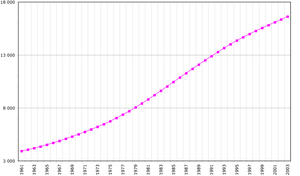Demographics of Côte d'Ivoire
2007 Schools Wikipedia Selection. Related subjects: African Geography
Demographic data from the CIA World Factbook
Population
- 17,654,843
- Note: estimates for this country explicitly take into account the effects of excess mortality due to AIDS; this can result in lower life expectancy, higher infant mortality and death rates, lower population and growth rates, and changes in the distribution of population by age and sex than would otherwise be expected (July 2006 est.)
Birth rate
- 35.11 births/1,000 population (2006 est.)
Death rate
- 14.84 deaths/1,000 population (2006 est.)
Net migration rate
- 0 migrant(s)/1,000 population (2006 est.)
Sex ratio
- At birth: 1.03 male(s)/female
- Under 15 years: 0.97 male(s)/female
- 15-64 years: 1.02 male(s)/female
- 65 years and over: 0.95 male(s)/female
- Total population: 1 male(s)/female (2006 est.)
- Under 15 years: 0.97 male(s)/female
Infant mortality rate
- Total: 89.11 deaths/1,000 live births
- Male: 105.73 deaths/1,000 live births
- Female: 71.99 deaths/1,000 live births (2006 est.)
- Male: 105.73 deaths/1,000 live births
Life expectancy at birth
- Total population: 48.82 years
- Male: 46.24 years
- Female: 51.48 years (2006 est.)
- Male: 46.24 years
Total fertility rate
- 4.58 children born/woman (2005 est.)
HIV/AIDS
- Adult prevalence rate: 7% (2003 est.)
- People living with HIV/AIDS: 570,000 (2003 est.)
- Deaths: 47,000 (2003 est.)
- People living with HIV/AIDS: 570,000 (2003 est.)
Major infectious diseases
- Degree of risk: very high
- Food or waterborne diseases: bacterial diarrhea, hepatitis A, and typhoid fever
- Vectorborne diseases: malaria, yellow fever, and others are high risks in some locations
- Water contact: schistosomiasis (2005)
- Food or waterborne diseases: bacterial diarrhea, hepatitis A, and typhoid fever
Nationality
- Noun: Ivoirian(s)
- Adjective: Ivoirian
Ethnic groups
- Akan 42.1%, Voltaiques or Gur 17.6%, Northern Mandes 16.5%, Krous 11%, Southern Mandes 10%, other 2.8% (includes 30,000 Lebanese and 45,000 French) (2004)
- Côte d'Ivoire has more than 60 ethnic groups, usually classified into five principal divisions: Akan (east and centre, including Lagoon peoples of the southeast), Krou (southwest), Southern Mandé (west), Northern Mandé (northwest), Sénoufo/ Lobi (north centre and northeast). The Baoulés, in the Akan division, probably comprise the largest single subgroup with 15%-20% of the population. They are based in the central region around Bouaké and Yamoussoukro. The Bétés in the Krou division, the Sénoufos in the north, and the Malinkés in the northwest and the cities are the next largest groups, with 10%-15% of the national population. Most of the principal divisions have a significant presence in neighboring countries.
- Of the more than 5 million non-Ivorian Africans living in Côte d'Ivoire, one-third to one-half are from Burkina Faso; the rest are from Ghana, Guinea, Mali, Nigeria, Benin, Sénégal, Liberia, and Mauritania. The non-African expatriate community includes roughly 50,000 French (this number may be inaccurate due to the evacuation of roughly 8,000 Frenchmen in November 2004) and possibly 30,000 Lebanese. The number of elementary school-aged children attending classes increased from 22% in 1960 to 67% in 1995.
Religions
- Christian 20-30%, Muslim 35-40%, indigenous 25-40% (2001)
- Note: the majority of foreigners (migratory workers) are Muslim (70%) and Christian (20%)
Languages
- French (official), 60 indigenous languages, of which the Dioula dialect of Bambara is the most widely spoken. Other languages include: the Gur languages, the Kru languages (including the Bété languages, Dida, Nyabwa, Wè, and Western Krahn), and the Kwa languages.
Literacy
- Definition: age 15 and over can read and write
- Total population: 50.9%
- Male: 57.9%
- Female: 43.6% (2003 est.)
- Total population: 50.9%
